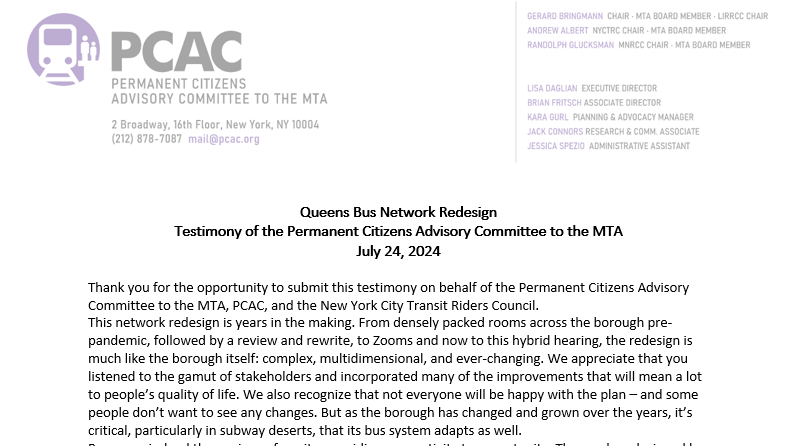Thank you for the opportunity to submit this testimony on behalf of the Permanent Citizens Advisory Committee to the MTA, PCAC, and the New York City Transit Riders Council.
This network redesign is years in the making. From densely packed rooms across the borough pre-pandemic, followed by a review and rewrite, to Zooms and now to this hybrid hearing, the redesign is much like the borough itself: complex, multidimensional, and ever-changing. We appreciate that you listened to the gamut of stakeholders and incorporated many of the improvements that will mean a lot to people’s quality of life. We also recognize that not everyone will be happy with the plan – and some people don’t want to see any changes. But as the borough has changed and grown over the years, it’s critical, particularly in subway deserts, that its bus system adapts as well.
Buses are indeed the engines of equity, providing connectivity to opportunity. The newly redesigned bus network invests an additional $30 million in Queens bus service, filling gaps in the existing network, which is largely based on old streetcar routes.
Since we have no idea when, or if, we’ll see the IBX, we need to be sure that New Yorkers can get where they need to go by bus. The redesign will help improve accessible travel around Queens and to other boroughs – particularly important with the loss of congestion pricing funds that would help pay for accessibility projects at 25 subway and LIRR stations around the city, including four in Queens. And it will help get people to LIRR stations to expand their travel options. Expanding options shouldn’t mean increasing costs, and with CityTicket now available 24/7, riding the railroad within the city is within the reach of more people.
Yet there’s more work to be done to ensure MTA riders are able to traverse the city using and transferring across whichever MTA mode is closest, fastest, and easiest for them. Allowing regular CityTicket users to buy a monthly ticket that is discounted thanks to the Outer Borough Transit Account and combining that with free transfers to buses and subways would make it more affordable and accessible to more people.
We again urge the MTA to adopt a combined monthly or weekly CityTicket, ideally funded through the OBTA.
Borough bus riders count on buses that run frequently and reliably. Increasing frequency on well-travelled routes and reducing things like traffic obstructions that slow buses down must go hand-in-hand. Expansion of the ACES program and Transit Signal Prioritization are crucial steps in the right direction, but we would also like to see Mayor Adams achieve, or even attempt to achieve, the Streets Plan’s mandate: constructing dedicated bus lanes and bus ways to speed buses – and bus riders – on their way.
Overall, we are optimistic about the Queens Bus Network Redesign plan. We applaud the tremendous amount of work and outreach that has gone into getting it where it is to help make buses faster, more reliable, and more frequent. We are hopeful that you will continue to adapt and expand as field testing turns into actual experience. We also hope to see the Brooklyn and Manhattan redesigns further expand inter-borough connectivity. We hope that new fare discounts and offerings will be introduced to incentivize riders who wish to switch between modes without incurring additional costs. And we hope that bus speeds continue to increase so that the engines of equity become a first choice, rather than a last resort, for so many working New Yorkers.
Thank you.
